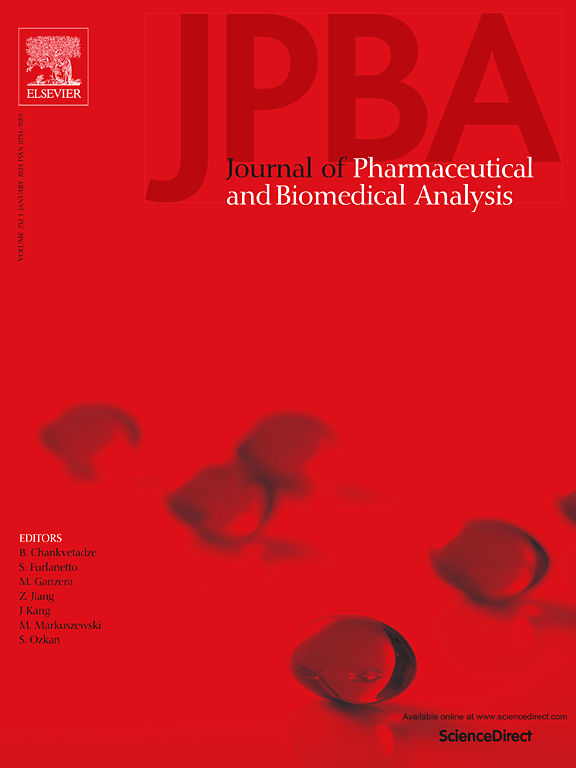同时测定十种抗菌药物的 LCMS/MS 方法及其在重症患者中的应用。
IF 3.1
3区 医学
Q2 CHEMISTRY, ANALYTICAL
Journal of pharmaceutical and biomedical analysis
Pub Date : 2024-09-30
DOI:10.1016/j.jpba.2024.116489
引用次数: 0
摘要
危重病人的药代动力学会发生显著变化,导致抗生素暴露不足和预后不良。在这项研究中,我们开发了一种简单、灵敏、快速的液相色谱串联质谱(LCMS/MS)平台,可同时定量检测 8 种抗菌药和 2 种抗真菌药,非常适合临床高效、实时的治疗药物监测(TDM)。该方法采用多重反应监测(MRM)质谱法,样品用甲醇沉淀蛋白质制备。色谱分离采用 BGIU Column-U02(2.1x50 毫米,3 微米),以六种稳定同位素和一种类似物作为内标。整个检测周转时间为 5 分钟。所有测试药物(哌拉西林、头孢哌酮、美罗培南、左氧氟沙星、莫西沙星、达托霉素、利奈唑胺、万古霉素、氟康唑和伏立康唑)在测试浓度范围内均呈线性(r ≥ 0.9900),准确度为 95 %-111 %,精密度变异系数大于或等于 10 %,定量下限为 0.31-7.51 mg/L,基质因子变异系数小于 10 %。回收率为 85% 至 115%,抗生素在 4°C 和 -20°C 温度下 6 天内稳定,偏移量大于或等于 15%。该方法成功应用于252名老年重症患者的常规TDM。本文章由计算机程序翻译,如有差异,请以英文原文为准。
An LCMS/MS method for the simultaneous determination of ten antimicrobials and its application in critically ill patients
Significant pharmacokinetic variation occurs in critically ill patients, leading to underexposure to antibiotics and poor prognosis. In this study, we developed a simple, sensitive, and fast liquid chromatography tandem mass spectrometry (LC![]() MS/MS) platform for the simultaneous quantification of 8 antibacterial and 2 antifungal drugs, which is optimally suited for clinically efficient, real-time therapeutic drug monitoring (TDM). Multiple reaction monitoring (MRM) mass spectrometry was used in this method, and samples were prepared via protein precipitation with methanol. Chromatographic separation was accomplished on a BGIU Column-U02 (2.1x50 mm, 3 µm), with six stable isotopes and one analog as an internal standard. The overall turnaround time of the assay was 5 minutes. All the drugs tested (piperacillin, cefoperazone, meropenem, levofloxacin, moxifloxacin, daptomycin, linezolid, vancomycin, fluconazole and voriconazole) were linear in the test concentration range (r ≥ 0.9900), the accuracy was 95 %-111 %, the precision variation coefficient was greater than or equal to 10 %, the lower limit of quantitation was 0.31–7.51 mg/L, and the coefficient of variation of the matrix factor was less than 10 %. The recovery rates ranged from 85 % to 115 %, and the antibiotics were stable at 4°C and −20°C for 6 days, with an offset of greater than or equal to 15 %. This method was successfully applied to routine TDM in 252 elderly critically ill patients.
MS/MS) platform for the simultaneous quantification of 8 antibacterial and 2 antifungal drugs, which is optimally suited for clinically efficient, real-time therapeutic drug monitoring (TDM). Multiple reaction monitoring (MRM) mass spectrometry was used in this method, and samples were prepared via protein precipitation with methanol. Chromatographic separation was accomplished on a BGIU Column-U02 (2.1x50 mm, 3 µm), with six stable isotopes and one analog as an internal standard. The overall turnaround time of the assay was 5 minutes. All the drugs tested (piperacillin, cefoperazone, meropenem, levofloxacin, moxifloxacin, daptomycin, linezolid, vancomycin, fluconazole and voriconazole) were linear in the test concentration range (r ≥ 0.9900), the accuracy was 95 %-111 %, the precision variation coefficient was greater than or equal to 10 %, the lower limit of quantitation was 0.31–7.51 mg/L, and the coefficient of variation of the matrix factor was less than 10 %. The recovery rates ranged from 85 % to 115 %, and the antibiotics were stable at 4°C and −20°C for 6 days, with an offset of greater than or equal to 15 %. This method was successfully applied to routine TDM in 252 elderly critically ill patients.
求助全文
通过发布文献求助,成功后即可免费获取论文全文。
去求助
来源期刊
CiteScore
6.70
自引率
5.90%
发文量
588
审稿时长
37 days
期刊介绍:
This journal is an international medium directed towards the needs of academic, clinical, government and industrial analysis by publishing original research reports and critical reviews on pharmaceutical and biomedical analysis. It covers the interdisciplinary aspects of analysis in the pharmaceutical, biomedical and clinical sciences, including developments in analytical methodology, instrumentation, computation and interpretation. Submissions on novel applications focusing on drug purity and stability studies, pharmacokinetics, therapeutic monitoring, metabolic profiling; drug-related aspects of analytical biochemistry and forensic toxicology; quality assurance in the pharmaceutical industry are also welcome.
Studies from areas of well established and poorly selective methods, such as UV-VIS spectrophotometry (including derivative and multi-wavelength measurements), basic electroanalytical (potentiometric, polarographic and voltammetric) methods, fluorimetry, flow-injection analysis, etc. are accepted for publication in exceptional cases only, if a unique and substantial advantage over presently known systems is demonstrated. The same applies to the assay of simple drug formulations by any kind of methods and the determination of drugs in biological samples based merely on spiked samples. Drug purity/stability studies should contain information on the structure elucidation of the impurities/degradants.

 求助内容:
求助内容: 应助结果提醒方式:
应助结果提醒方式:


